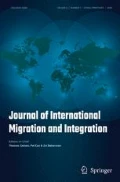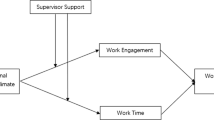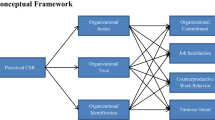Abstract
The National Immigration Agency of Taiwan reported that, by 2014, more than 498,000 immigrant spouses were registered in Taiwanese households, 91 % of which was female. Immigrant wives are now a significant part of Taiwanese society, and they are an important aspect of the labor force in Taiwan’s economy. However, they face major challenges in the workplace, which influences their work outcomes, results in a reduced labor force for enterprises, and increases societal costs. This pioneering study employed the person-environment fit and locus of control concepts from the organizational behavior field to address this issue. A sample of 130 immigrant wives from Indonesia and Vietnam living in Taiwan was surveyed. The results of a hierarchical regression analysis found that immigrant wives’ person-job fit and person-supervisor fit significantly influenced their affective commitments to their workplaces. An external locus of control significantly weakened the relationship between person-environment fit and affective commitment. The contributions and implications of the study results were discussed.


Similar content being viewed by others
References
Allen, N. J., & Meyer, J. P. (1991). A three-component conceptualization of organizational commitment. Human Resource Management Review, 1, 61–98.
Autry, C. W., & Daugherty, P. J. (2003). Warehouse operations employees: linking person-organization fit, job satisfaction, and coping responses. Journal of Business Logistics, 24, 171–197.
Bretz, R. D., & Judge, T. A. (1994). Person-organization fit and the theory of work adjustment: implications for satisfaction, tenure, and career success. Journal of Vocational Behavior, 44, 32–54.
Cable, D. M., & DeRue, D. S. (2002). The convergent and discriminant validity of subjective fit perceptions. Journal of Applied Psychology, 87(5), 875–884.
Cable, D. M., & Judge, T. A. (1996). Person organization fit, job choice decisions, and organizational entry. Organizational Behavior and Human Decision Processes, 67, 294–311.
Caldwell, D. F., & O’Reilly, C. A. (1990). Measuring a person-job fit with a profile-comparison process. Journal of Applied Psychology, 75(6), 648–657.
Caplan, R. D. (1987). Person-environment fit theory and organizations: commensurate dimensions, time perspectives, and mechanisms. Journal of Vocational Behavior, 31, 248–267.
Carmeli, A. (2005). Perceived external prestige, affective commitment, and citizenship behaviors. Organization Studies, 26(3), 443–464.
Chatman, J. A. (1991). Matching people and organizations: selection and socialization in public accounting firms. Administrative Science Quarterly, 36, 459–484.
Cheng, C.Y. (2010). The effectiveness evaluation of training programs to immigrant spouses. Unpublished investigation report. Taiwan Research and Development Center of Labor Education.
Chuang, A. C., & Lin, H. Y. (2005). An investigation of the effect of person-environment fit on work attitudes and behaviors. Taiwan Academy of Management Journal, 5(1), 123–148.
Coleman, D. F., Irving, G. P., & Cooper, C. L. (1999). Another look at the locus of control organizational commitment relationship: it depends on the form of commitment. Journal of Organizational Behavior, 20, 995–1001.
Driskell, J. E., Hogan, R., & Salas, E. (1987). Personality and group performance. In C. Hendrick (Ed.), Review of personality and social psychology (pp. 91–112). Beverly Hills: Sage.
Edwards, J. R. (2008). Person-environment fit in organizations: an assessment of theoretical progress. The Academy of Management Annals, 2, 167–230.
Felfe, J., & Yan, W. H. (2009). The impact of workgroup commitment on organizational citizenship behaviour, absenteeism and turnover intention: the case of Germany and China. Asia Pacific Business Review, 15(3), 433–450.
Furnham, A. (1994). Personality at work. London: Routledge.
Gao, S.Q. (2000). Dual-earner couples: the start of burden-sharing. Family Education: 131–154.
Greguras, G. J., & Diefendorff, J. M. (2009). Different fits satisfy different needs: linking person-environment fit to employee commitment and performance using self-determination theory. Journal of Applied Psychology, 94(2), 465–477.
Guzzo, R., & Salas, E. (1995). Team effectiveness and decision making in organizations. San Francisco: Jossey-Bass.
Hackman, J. R., & Morris, C. G. (1975). Group tasks, group interaction process, and group performance effectiveness: a review and proposed integration. In L. Berkowitz (Ed.), Advances in experimental social psychology (pp. 45–99). New York: Academic.
Hair, J., Anderson, R., Tatham, R., & Black, W. (1998). Multivariate data analysis (5th ed.). Upper Saddle River: Prentice-Hall.
Harris, S. G., & Mossholder, K. W. (1996). The affective implications of perceived congruence with culture dimensions during organizational transformation. Journal of Management, 22, 527–547.
Haythorn, W. W. (1968). The composition of groups: a review of the literature. Acta Psychological, 28, 97–128.
Herndon, N. C., Fraedrich, J. P., & Yeh, Q. J. (2001). An investigation of moral values and the ethical content of the corporate culture: Taiwanese versus U.S. sales people. Journal of Business Ethics, 30(1), 773–785.
Hidalgo, D. A., & Bankston, C. L., III. (2011). The demilitarization of Thai American marriage migration, 1980–2000. Journal of International Migration and Integration, 12, 85–99.
Hoerr, J. (1989). The payoff from teamwork. Business Week:56–62.
Hsia, H. R. (2002). Drifting toward the shore—the phenomenon of “immigrant wives” under capital globalization. Taipei: A Radical Quarterly in Social Studies.
Judge, T. A., & Bono, J. E. (2001). Relationship of core self-evaluation traits-self-esteem, generalized self-efficacy, locus of control and emotional stability—with job satisfaction and job performance: a meta-analysis. Journal of Applied Psychology, 86(1), 80–92.
Judge, T. A., & Ferris, G. R. (1992). The elusive criterion of fit in human resource staffing decisions. Human Resource Planning, 15(4), 47–67.
Kinicki, A. J., & Vecchio, R. P. (1994). Influences on the quality of supervisor-subordinate relations: the role of time-pressure, organizational commitment, and locus of control. Journal of Organizational Behavior, 15, 75–82.
Klimoski, R. J., & Jones, R. G. (1995). In R. Guzzo & E. Salas (Eds.), Staffing for effective group decision making: key issues in matching people and teams: team effectiveness and decision making in organizations. San Francisco: Jossey-Bass.
Kristof-Brown, A. L. (1996). Person-organization fit: an integrative review of its conceptualizations, measurement, and implications. Personnel Psychology, 49, 1–49.
Kristof-Brown, A. L., & Guay, R. P. (2011). Person–environment fit. APA Handbook of Industrial and Organizational Psychology, 3, 3–50. doi:10.1037/12171-001.
Kristof-Brown, A. L., & Stevens, C. K. (2001). Goal congruence in project teams: does the fit between members’ personal mastery and performance goals matter? Journal of Applied Psychology, 86, 1083–1095.
Kristof-Brown, A. L., Zimmerman, R. D., & Johnson, E. C. (2005). Consequences of individuals’ fit at work: a meta-analysis of person-job, person-organization, person-group, and person-supervisor fit. Personnel Psychology, 58, 281–342.
Lam, S. S. K., & Schaubroeck, J. (2000). The role of locus of control in reactions to being promoted and to being passed over: a quasi experiment. Academy of Management Journal, 43(1), 66–78.
Levenson, H. (1974). Activism and powerful others: distinctions within the concept of internal-external control. Journal of Personality Assessment, 38, 377–383.
Levenson, H. (1981). Differentiating among internality, powerful others, and chance. In H. M. Lefcourt (Ed.), Research with the locus of control construct. New York: Academic.
Li, M.T., & Huang, Y.H. (2008). The research trend analysis for the east-southern spouse in Taiwan during the past decade—taking the nationwide theses as the examples. Paper presented at the 2008 Annual Conference on Southeast Asian Studies in Taiwan, Asia University, Taichung
McIntyre, N., Srivastava, A., & Fuller, J. A. (2009). The relationship of locus of control and motives with psychological ownership in organizations. Journal of Managerial Issues, 21(3), 383–401.
Meglino, B. M., Ravlin, E. C., & Adkins, C. L. (1989). A work values approach to corporate culture: a field test of the value congruence process and its relationship to individual outcomes. Journal of Applied Psychology, 74, 424–432.
Meyer, J. P., Allen, N. J., & Smith, C. A. (1993). Commitment to organizations and occupations: extension and test of the three-component conceptualization. Journal of Applied Psychology, 78, 538–551.
Millward, L. J., & Brewerton, P. M. (2002). Psychological contracts: employee relations for the twenty-first century? International Review of Industrial and Organizational Psychology, 15, 1–61.
Mohamed, F., Taylor, G. S., & Hassan. (2006). Affective commitment and intent to quit: the impact of work and non-work related issues. Journal of Managerial Issues, 18(4), 512–529.
Mowday, R. T., Poter, L. W., & Steers, R. M. (1982). Employee-organization linkages: the psychology of commitment, absenteeism, and turnover. New York: Academic.
Namini, S., Appel, C., Jürgensen, R., & Murken, S. (2010). How is well-being related to membership in new religious movements? An application of person-environment fit theory. Applied Psychology, 59(2), 181–201.
Ng, T. W. H., & Butts, M. M. (2009). Effectiveness of organizational efforts to lower turnover intentions: the moderating role of employee locus of control. Human Resource Management, 48(2), 289–310.
Ng, T. W. H., Sorensen, K. L., & Eby, L. T. (2006). Locus of control at work: a meta-analysis. Journal of Organizational Behavior, 27, 1057–1087.
Norris, D. R., & Niebuhr, R. E. (1984). Attributional influences on the job performance-job satisfaction relationship. Academy of Management, 27(2), 424–431.
Oxman-Matinez, J., Matinez, A., & Hanley, J. (2001). Trafficking women: gendered impacts of Canadian immigration policies. Journal of International Migration and Integration, 2(3), 297–313.
Podsakoff, P. M., & Organ, D. W. (1986). Self-reports in organizational research: problems and prospects. Journal of Management, 12(4), 531–544.
Riaño, Y., & Baghdadi, N. (2007). Understanding the labour market participation of skilled immigrant women in Switzerland: the interplay of class, ethnicity, and gender. Journal of International Migration and Integration, 8, 163–183.
Rotter, J. B. (1954). Social learning and clinical psychology. Englewood Cliffs. NJ: Prentice-Hall.
Rotter, J. B. (1966). Generalized expectancies for external versus external control of reinforcement. Psychological Monographs, 80, 1–27.
Ryan, A. M., & Kristof-Brown, A. L. (2003). Focusing on personality in person– organization fit research: Unaddressed issues. In M. R. Barrick & A. M. Ryan (Eds.), Personality and work: Reconsidering the role of personality in organizations (pp. 262–288). San Francisco: Jossey-Bass.
Schyns, B., & Collani, G. V. (2002). A new occupational self-efficacy scale and its relation to personality constructs and organizational variables. European Journal of Work and Organizational Psychology, 1(2), 219–241.
Shaw, M. E. (1981). Group dynamics: the psychology of small group behavior (3rd ed.). New York: McGraw-Hill.
Srivastava, S. (2009). Locus of control as a moderator for relationship between organizational role stress and managerial effectiveness. Vision, 13(4), 49–61.
Tinsley, H. E. A. (2000). The congruence myth: an analysis of the efficacy of the person–environment fit model. Journal of Vocational Behavior, 56, 147–179.
Tsui, A. S., & O’Reilly, C. A. (1989). Beyond simple demographic affects: the importance of relational demography in superior-subordinate dyads. Academy of Management Journal, 32, 402–423.
Vandenberghe, C., Bentein, K., & Stinglhamber, F. (2004). Affective commitment to the organization, supervisor, and work group: antecedents and outcomes. Journal of Vocational Behavior, 64(1), 47–71.
Wang, M. H. (2004). An analysis of the structural minority situation on Taiwan’s foreign brides. Community Development Quarterly, 107, 320–334.
Wang, Q., Bowling, N., & Eschleman, K. (2010). A meta-analytic examination of work and general locus of control. Journal of Applied Psychology, 95(4), 761–768.
Weldon, E., & Weingart, L. R. (1993). Group goals and group performance. British Journal of Social Psychology, 32, 307–334.
Werbel, J. D., & Gilliland, S. W. (1999). Person–environment fit in the selection process. In G. R. Ferris (Ed.), Research in human resources management, vol. 17 (pp. 209–243). US: Elsevier Science/JAI Press. IX, 321 pp.
Wu, X. Z. (2004). Initial investigation on South-East Asian immigrant wives’ view on the education environment for developmental challenged children and their experiences—an ecosystem and relevant studies-based analysis. Community Development Quarterly, 105, 159–175.
Wu, T. X., Wu, K. C., Liu, Y. X., & Ou, H. M. (1996). Editing and research for work value inventory (WVI). Taipei: National Youth Commission, Executive Yuan, Taiwan.
Young, A. M., & Hurlic, D. (2007). Gender enactment at work: the importance of gender and gender-related behavior to person-organizational fit and career decisions. Journal of Managerial Psychology, 22(2), 168–187.
Zenger, T. R., & Lawrence, B. S. (1989). Organizational demography: the differential effects of age and tenure distribution on technical communication. Academy of Management Journal, 32, 353–376.
Zhu, B.L. (2005). An investigation of foreign labor and immigrant spouses management. Taipei: National Policy Foundation-Report on National Policy of External Affairs, pp. 094–003. Living conditions investigation of immigrant wives in 2008, conducted by the Ministry of the Interior of Taiwan. https://www.immigration.gov.tw/public/Data/091020261071.doc. Accessed 16 Mar 2012).
Acknowledgments
We would like to express our sincere gratitude to Y.W. Chen, Y. S. Fang, and Y. C. Hsu for their help in collecting the sample data.
Author information
Authors and Affiliations
Corresponding author
Rights and permissions
About this article
Cite this article
Tsai, P.CF., Tsao, CW. The Effects of Person-Environment Fit and External Locus of Control on Organizational Affective Commitment: a Study of Immigrant Wives in Taiwan. Int. Migration & Integration 18, 699–717 (2017). https://doi.org/10.1007/s12134-016-0493-x
Published:
Issue Date:
DOI: https://doi.org/10.1007/s12134-016-0493-x




